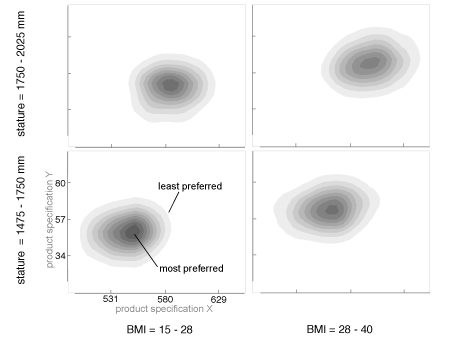The quality of available education, solution techniques, and tools for designers considering user body size in the development of products and environments varies widely. The objective of this work is to investigate the current state of affairs in these areas, propose new or improved methods and tools where appropriate, and evaluate these tools.
The multivariate nature of typical problems involving body size and shape—also called anthropometry—makes it difficult to precisely configure a product that meets the needs of a target population of users. As a result, designers may overestimate the robustness of their designs, and many users may be unintentionally excluded by design limitations in some way. This has implications for the safety and comfort of the users, and manufacturers may experience decreased market share and profits as well as regulatory violations for failing to properly consider the spatial requirements of the users of their products. Three objectives/broad impacts of the research are: (1) understand challenges facing appropriate application of anthropometry for design, (2) determine effective alternatives to traditional methods of designing for body size and shape, and (3) develop recommendations that capitalize on the findings for effective alternatives.
To support the three broad impacts, four areas of activity were explored for the research: (1) assessment of human factors/ergonomics (HF/E) education by sampling available course syllabi for courses addressing physical ergonomics in the U.S., (2) assessment of industrial application of practices for designing for user body size and shape via conversations with industrial practitioners in the United States and the Republic of Ireland, (3) experimental evaluation of new representations and tools for visualizing and interacting with multivariate anthropometric data with participants acting as “designers”, and (4) implementation of the findings in practical recommendations and a prototype mobile application.
Several key results follow from the four areas of research activity, and a few of them are highlighted here. The course syllabi survey showed that anthropometry is covered in the vast majority of courses, but receives an average of only 9% (1.6 days) of lecture time. Most course texts’ treatment of anthropometry indicates that students are not provided with adequate tools to properly design for body size due to inappropriate, insufficient, or outdated anthropometric data. The survey of ergonomics practitioners showed that designing for the industry-standard 5th-95th percentile accommodation is a common goal among ergonomics specialists. The survey also showed that both specialists and general design practitioners make use of the traditional Dreyfuss templates (e.g., Measure of Man) despite important limitations on their use. Awareness of principles and tools for designing for body size was the greatest challenge identified by respondents, along with availability of reliable anthropometric data.
Two experimental web-based evaluations of representations showed, among other findings, that employing interactivity in tools for designing for human variability enhanced subjective measures of tool performance, representative humanoid glyphs are insightful and need not be intricate to be effective, and familiar and well-laid-out figures provide the most benefit for designers considering body size. These results are combined with best practices for designing for human variability to develop a set of recommendations and a prototype mobile application for designing for anthropometry.
The impact of the work is far-reaching—offering guidance for developing improved tools for designers, improved comfort and safety for users, and enhanced profit and easier regulatory compliance for manufacturers. The research may find application for a wide variety of products, from cars and aircraft to workstations and hand tools. The research is also relevant to a broad audience, from students and practitioners to architects and product designers.

